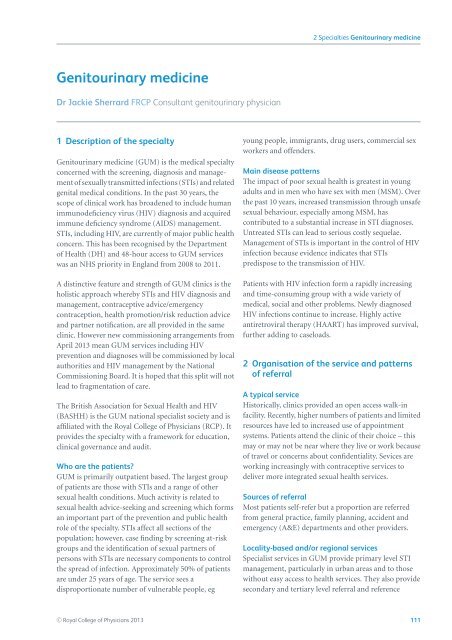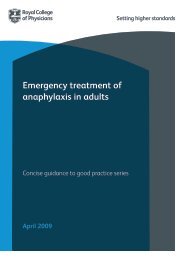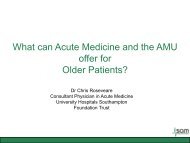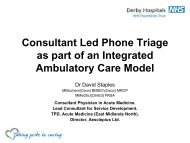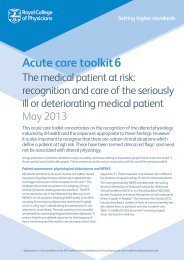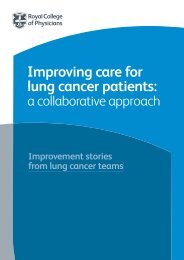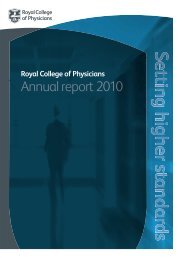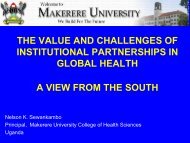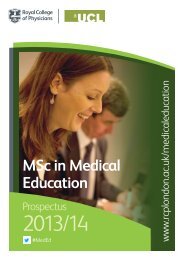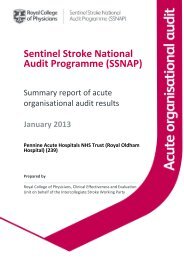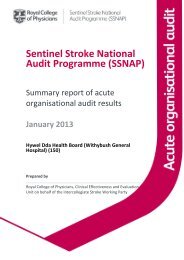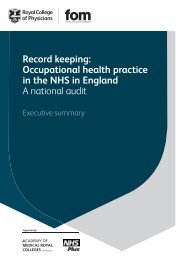Consultant physicians working with patients - Royal College of ...
Consultant physicians working with patients - Royal College of ...
Consultant physicians working with patients - Royal College of ...
Create successful ePaper yourself
Turn your PDF publications into a flip-book with our unique Google optimized e-Paper software.
2 Specialties Genitourinary medicineGenitourinary medicineDr Jackie Sherrard FRCP <strong>Consultant</strong> genitourinary physician1 Description <strong>of</strong> the specialtyGenitourinary medicine (GUM) is the medical specialtyconcerned <strong>with</strong> the screening, diagnosis and management<strong>of</strong> sexually transmitted infections (STIs) and relatedgenital medical conditions. In the past 30 years, thescope <strong>of</strong> clinical work has broadened to include humanimmunodeficiency virus (HIV) diagnosis and acquiredimmune deficiency syndrome (AIDS) management.STIs, including HIV, are currently <strong>of</strong> major public healthconcern. This has been recognised by the Department<strong>of</strong> Health (DH) and 48-hour access to GUM serviceswas an NHS priority in England from 2008 to 2011.A distinctive feature and strength <strong>of</strong> GUM clinics is theholistic approach whereby STIs and HIV diagnosis andmanagement, contraceptive advice/emergencycontraception, health promotion/risk reduction adviceand partner notification, are all provided in the sameclinic. However new commissioning arrangements fromApril 2013 mean GUM services including HIVprevention and diagnoses will be commissioned by localauthorities and HIV management by the NationalCommissioning Board. It is hoped that this split will notlead to fragmentation <strong>of</strong> care.The British Association for Sexual Health and HIV(BASHH) is the GUM national specialist society and isaffiliated <strong>with</strong> the <strong>Royal</strong> <strong>College</strong> <strong>of</strong> Physicians (RCP). Itprovides the specialty <strong>with</strong> a framework for education,clinical governance and audit.Who are the <strong>patients</strong>?GUM is primarily outpatient based. The largest group<strong>of</strong> <strong>patients</strong> are those <strong>with</strong> STIs and a range <strong>of</strong> othersexual health conditions. Much activity is related tosexual health advice-seeking and screening which formsan important part <strong>of</strong> the prevention and public healthrole <strong>of</strong> the specialty. STIs affect all sections <strong>of</strong> thepopulation; however, case finding by screening at-riskgroups and the identification <strong>of</strong> sexual partners <strong>of</strong>persons <strong>with</strong> STIs are necessary components to controlthe spread <strong>of</strong> infection. Approximately 50% <strong>of</strong> <strong>patients</strong>are under 25 years <strong>of</strong> age. The service sees adisproportionate number <strong>of</strong> vulnerable people, egyoung people, immigrants, drug users, commercial sexworkers and <strong>of</strong>fenders.Main disease patternsThe impact <strong>of</strong> poor sexual health is greatest in youngadults and in men who have sex <strong>with</strong> men (MSM). Overthe past 10 years, increased transmission through unsafesexual behaviour, especially among MSM, hascontributed to a substantial increase in STI diagnoses.Untreated STIs can lead to serious costly sequelae.Management <strong>of</strong> STIs is important in the control <strong>of</strong> HIVinfection because evidence indicates that STIspredispose to the transmission <strong>of</strong> HIV.Patients <strong>with</strong> HIV infection form a rapidly increasingand time-consuming group <strong>with</strong> a wide variety <strong>of</strong>medical, social and other problems. Newly diagnosedHIV infections continue to increase. Highly activeantiretroviral therapy (HAART) has improved survival,further adding to caseloads.2 Organisation <strong>of</strong> the service and patterns<strong>of</strong> referralA typical serviceHistorically, clinics provided an open access walk-infacility. Recently, higher numbers <strong>of</strong> <strong>patients</strong> and limitedresources have led to increased use <strong>of</strong> appointmentsystems. Patients attend the clinic <strong>of</strong> their choice – thismay or may not be near where they live or work because<strong>of</strong> travel or concerns about confidentiality. Sevices are<strong>working</strong> increasingly <strong>with</strong> contraceptive services todeliver more integrated sexual health services.Sources <strong>of</strong> referralMost <strong>patients</strong> self-refer but a proportion are referredfrom general practice, family planning, accident andemergency (A&E) departments and other providers.Locality-based and/or regional servicesSpecialist services in GUM provide primary level STImanagement, particularly in urban areas and to those<strong>with</strong>out easy access to health services. They also providesecondary and tertiary level referral and referenceC○ <strong>Royal</strong> <strong>College</strong> <strong>of</strong> Physicians 2013 111


